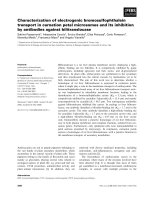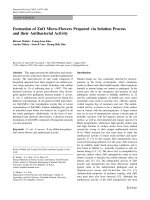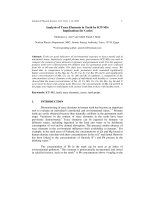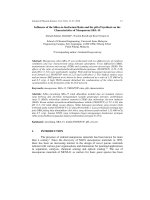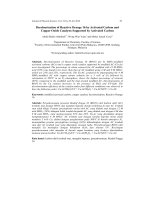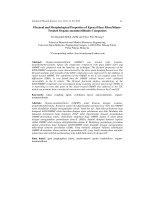Báo cáo vật lý: "Using of HPLC Analysis for Evaluation of Residual Monomer Content in Denture Base Material and Their Effect on Mechanical Properties" pptx
Bạn đang xem bản rút gọn của tài liệu. Xem và tải ngay bản đầy đủ của tài liệu tại đây (217.26 KB, 9 trang )
Journal of Physical Science, Vol. 19(2), 127–135, 2008 127
Using of HPLC Analysis for Evaluation of Residual Monomer
Content in Denture Base Material and Their Effect on Mechanical
Properties
S.H. Mohamed
1
, Alb. M. Al-Jadi
2
and T. Ajaal
2
1
Higher Institute of Medical Technology, P.O. Box 1458, Misurata, Libya
2
Academic of Postgraduate Studies, Tripoli, Libya
*Corresponding author:
Abstract: The samples were prepared according to the routine work for sample
preparation in dental laboratories. After reaching dough stage, the mixture packed into
dumbbell shaped of stainless steel mould and pressed in a hydraulic bench press for
25 min at room temperature. For heat-cure, the polymerization cycle was carried out
using water bath, while self-cure done at room temperature. The residual monomer
content was evaluated using high performance liquid chromatography (HPLC). The
tensile test was evaluated in dry and wet condition (distilled water). The results showed
that the residual monomer content for heat-cure samples was 1.44 wt. % while self-cure
samples was 8.71 wt. %. The residual monomer content of heat-cure samples was comply
with ISO-1567 standard for denture base material. The heat-cure material depicted
higher tensile strength, tensile strain and energy at break than that of self-cure material.
This is due to higher residual monomer content in self-cure which acts as plasticizer,
subsequently lead to reduce the properties of self-cure material. After immersion, the
tensile strength, tensile strain and energy at break of heat-cure samples found to
decrease, while the self-cure samples were found to increase. Generally, the heat-cure
material showed better properties compared to self-cure material.
Keywords: residual monomer, mechanical properties, denture base materials
1. INTRODUCTION
Poly (methyl methacrylate) (PMMA) is currently the material of choice
for denture base fabrication. The denture base resin is subjected to various
stresses during function. During fabrication of a denture, the physical and
mechanical properties influence by cure condition and choice of materials. Each
cure cycle or fabrication technique is a compromise that attempts to optimize the
properties thought important for a given application. Dentists and manufacturers
of denture base materials have long been searching for ideal materials and
designs for dentures. So far, the results have been noteworthy although there are
still some physical and mechanical problems with these materials.
During clinical use, the denture base materials are immersed in saliva and
when not in use may be soaked in water. When immersed in such solutions,
HPLC Analysis for Evaluation 128
plasticizers and other soluble components may leach out over extended periods,
while water or saliva is absorbed. The loss of plasticizer may cause brittleness
and increased hardness values. Several investigators have evaluated the effect of
water on the bond strength of acrylic materials and demonstrated that absorbed
water can have a detrimental effect on bond strength to acrylic resin.
Furthermore, Dootz et al.
1
have shown that material aging can dramatically
affects the physical and mechanical properties.
Sanders et al.
2
compared acrylic resin record bases made from three
commercial resins processed by water bath curing and microwave curing energy.
The adaptation of the record bases to a standard cast was measured to determine
if there were any statistical significant differences in the fit that could be
attributed to the differences in curing methods and the brands of resin. The results
indicated a small statistically significant difference in favor of the water bath cure
but clinically there were no appreciable differences in the adaptation of the record
bases with either curing method or the resins used. The adaptation of artificial
dentures made from acrylic resins is clinically acceptable with either microwave
curing or the water bath method. Lai et al.
3
compared between the conventional
method (water bath heat-cure) and microwave method, where meterials were
tested for hardness, porosity, flexural properties, solubility and molecular weight.
They found no difference in the mean values of surface hardness and the weight
percentages of the insoluble parts. The mean domain size and the volume fraction
of the rubber phase favor that of the water-bath cured specimens.
Naik and Jabade
4
evaluated and compared the transverse and impact
strength of a new high-impact denture base resin with the two most commonly
available resins in the market. The materials used were DPI-TUFF, Lucitone 199
and DPI heat-cure denture base resins. They found that the use of long
polymerization cycle increases the transverse and impact strength values of these
materials as compared to the use of short polymerization cycle.
In the present study, the residual monomer content was evaluated by
HPLC, and mechanical properties of heat-cure and self-cure denture base
materials were checked out in both dry and wet condition using distilled water.
2. EXPERIMENTAL
2.1 Materials
Two denture base materials that were commercially available, heat-cure
and self-cure were supplied by Meliodent-Germany in the form of powder and
liquid. The powder contains approximately 97% PMMA polymer while the liquid
Journal of Physical Science, Vol. 19(2), 127–135, 2008 129
is methyl methacrylate monomer mixed with dimethacrylate as the cross-linking
agent.
2.2 Specimen Preparation
2.2.1 Heat-cure denture base material
Specimens of heat-cure polymerized denture base were prepared as
recommended by the manufacturer and the daily routine work for sample
preparation in dental laboratory was followed. The recommended mixing ratio for
heat-cure was 35 g powder to 14 ml liquid. The required amount of liquid poured
into a mixing jar, then the powder was added carefully until the powder
completely wetted by liquid. After reaching dough stage, the mixture packed into
dumbbell shaped stainless steel mould. A thin layer of polyethylene sheet was
used as the separating media. It was then pressed in a hydraulic bench press for
25 min at room temperature. The polymerization cycle that carried out using
water bath at boiling temperature was then switched off and left for 15 min. It
was then boiled again for 20 min and then switched off let it to cool down slowly.
Specimen was taken out from mould and the excess margins were polished by the
sandpaper.
2.2.2 Self-cure denture base material
The recommended mixing ratio was 10 g powder to 7 ml liquid. The
required amount of liquid poured into a mixing jar, and with the corresponding
amount of powder added, it was mixed thoroughly for approximately 30 s. After
reaching dough stage, the mixture packed into dumbbell shaped of stainless steel
mould, and with a thin layer of polyethylene sheet used as the separating media,
it was pressed under a pressure of 2 pars. The processing and hardening time at
room temperature were approximately 2 min and 10–14 min, respectively.
2.2.3 Determination of residual monomer in the denture base
materials using HPLC
HPLC was used to quantity the residual methyl methacrylate (MMA)
content in the sample of heat-cure and self-cure material. A sample of 50 mg was
dissolved in 1 ml of acetone and then 10 ml of methanol was added to the
solution to precipitate the polymer. The supernatant of solution was filtered
through a 0.45 μm pore Millipore filter. HPLC analysis was performed using LC-
2010C Shimadzu Japan system equipped with a CAPCELL PAK C18 column.
Ten ml of the sample solution was injected and analyzed at 40ºC at a flow rate of
1.0 ml min
–1
with acetonitrile water (50/50). This procedure previously described
HPLC Analysis for Evaluation 130
by Ohyama and Imai.
5
The calculation content of MMA (x) in 1 g was calculated
using the following formula:
(MMA) X = (Pvz x nst x Cst x 20) / (Pst x nvz) (1)
Where,
Pvz = Average of injected area, nst = weight of standard sample, Cst = purity of
sample, Pst = Average weight of standard sample, and nvz = sample weight.
2.2.4 Tensile tests
Tensile tests were carried out according to ASTM D-638 types IV using
electromechanical tensile testing machine (TIRA testing machine, 2850-S 50
KN, Germany). The gauge length was set at 50 mm and crosshead speed at
5 mm min
–1
. At least five samples were tested for each formulation. Tensile
strength, energy at break as well as tensile strain were recorded.
2.2.5 Effect of aqueous environmental on tensile properties
The tensile samples were immersed in distilled water and at room
temperature. They were tested at intervals of 1, 7 and 30 days. The specimen’s
outer surfaces were then manually dried with soft tissue paper. The tensile test
was then applied according to the procedures described in previous section.
3. RESULTS AND DISCUSSION
3.1 Residual Monomer Test (HPLC)
Figures 1 and 2 show the diagram of residual MMA collected from 1 g
sample of PMMA for heat-cure and self-cure denture base materials,
respectively. The content of MMA was calculated from the area under the peak
after 6 min from injection of the sample as shown in the diagram. The average of
12 readings of each sample of heat-cure and self-cure denture base materials were
shown in Table 1. The results of MMA content were 23.28 mg g
–1
(1.44 wt. %)
and 140.02 mg g
–1
(8.71 wt. %) of heat and self-cure, respectively. It can be seen
that the residual monomer content of heat-cure samples was lower than that of the
self-cure as well as the ISO-1567 (2000) standard for denture base material. In
this study, the curing types (heat-cure and self-cure) have a great influence in
reducing the residual monomer content which is in agreement with many
researches who reported similar findings.
5–7
Significant difference was found in
Journal of Physical Science, Vol. 19(2), 127–135, 2008 131
both heat-cure and self-cure denture base materials in terms of residual monomer
content. The self-cure contained residual MMA of 8.71 wt. % which failed to
comply with the requirements of ISO 1567 Standard, while the heat-cure passed
the requirements regarding residual MMA.
Volts
0.000 0.025 0.050 0.075 0.100 0.125 0.150
0 1 2 3 4 5 6 7 8 9 10
Min
Figure 1: Residual MMA diagram collected from 1 g sample of PMMA for heat-cure
denture base material.
Volts
0.000 0.025 0.050 0.075 0.100 0.125 0.150
0 1 2 3 4 5 6 7 8 9 10
Min
Figure 2: Residual MMA diagram collected from 1 g sample of PMMA for self-cure
denture base material.
HPLC Analysis for Evaluation 132
Table 1: The results of MMA content of denture base materials compared with ISO
standard.
Denture base material Heat-cure Self-cure ISO -1567
wt. % 1.44 8.71 2.2
mass 23.28 140.02 35.37
Miettinen and Vallittu
8
compared the residual monomer content released
from heat-cure and self-cure denture base materials and concluded that the self-
cure materials released considerably more residual MMA than the heat-cure
materials (1–2 wt. %). Moreover, the authors showed that the residual monomer
content could be reduced when the polymerization time was extended.
Dogan et al.
9
studied the effects of varying polymerization times and
temperatures on the residual monomer content of polymer/monomer-based
denture base materials. The authors showed that increased temperatures and
extended polymerization time were accompanied by a decrease in the residual
monomer content.
3.2 Tensile Properties
3.2.1 Tensile properties at room temperature (dry condition)
Table 2 shows the results of tensile properties of heat-cure and self-cure
denture base materials. It can be seen that the heat-cure samples displayed higher
tensile properties. The tensile strength of heat-cure was higher by 15.46% than
that of self-cure. While the tensile strain was higher by 12.14%, the energy at
break also showed higher value by 6.48%. This is due to the higher amount of
residual monomer content in self-cure samples (Table 1), which act as plasticizer
and give dramatically lower strength. However, tensile modulus of heat-cure was
lower by 6.25% which indicated that the self-cure samples were stiffer and less
flexible than the heat-cure samples. The results of current study in agreement
with other researchers who found that water bath polymerization results in
enhanced mechanical properties.
6,7,10
In addition, Dogan et al.
9
evaluated the
tensile properties of denture base material related to the effect of level of residual
monomer, and concluded that the percentage of higher levels of residual
monomer effected on the tensile properties of denture base material.
Table 2: Results of tensile properties of heat-cure and self-cure denture base materials at
room temperature.
Sample Tensile strength
(MPa)
Tensile strain
(%)
Energy at break
(N m
–
²)
Tensile modulus
(GPa)
Heat-cure 70.13 6.26 3.24 1.20
Self-cure 59.29 5.50 3.03 1.28
Journal of Physical Science, Vol. 19(2), 127–135, 2008 133
3.2.2 Effect of aqueous environments on tensile properties
The effects of distilled water on tensile properties of denture base
materials are shown in Table 3. Heat-cure and self-cure denture base materials
were significantly different in their tensile strength. After immersion in the
water, the tensile strength was found to decrease due to the absorption of
water which acts as plasticizer. The heat-cure sample decreased by 18.11%
after 30 days compared to one day immersion. While tensile strain dropped by
19.08%, at the same time, energy at break was lower by 12.14%. This may be
attributed to the presence of water in the polymer acting as an internal
plasticizer which increases the plasticity as reported by Deb et al.
11
The tensile strength of self-cure sample was found to increase after
immersion from one day to 30 days. Tensile strength increased by 11.24%
while tensile strain, energy at break and tensile modulus found to decrease.
After immersion in the water, the residual monomer content can leach out and
the water replace them. However, once the majority of the leachable
components are extracted.
During storage in an aqueous environment, two processes were occured
simultaneously. First, post-curing of the denture base and leaching of the
residual monomer where both effects reduced the amount of monomer in the
denture base. The second was water uptake. The changes observed in tensile
strength may be due to the water which actually not reducing the strength of
the bonds within the PMMA, but allowing the chains to slip over each other
more easily. Thus, reducing the stiffness and increasing the ability of the
matrix to extend prior to failure. The tensile strain and energy at break showed
similar trends to that of tensile strength, with a decrease in stiffness and
increase in ductility after a period of immersion in distilled water.
After analyzing the results obtained in the present study, the tensile
properties of heat-cure were better compared to self-cure denture base
materials. Tsuchiya et al.
12
demonstrated that the residual monomer content of
denture base materials is lowered to a quarter of the initial value if the denture
is immersed in water at 50°C for one hour after polymerization.
HPLC Analysis for Evaluation 134
Table 3: The result of the tensile properties of denture base materials after immersed in
distilled water.
Sample Tensile strength
(MPa)
Tensile strain
(%)
Energy at break
(N m
–
²)
Tensile modulus
(GPa)
Heat-cure 1 day 70.05 6.76 3.13 1.21
Self-cure 1 day 51.78 5.64 2.9 1.03
Heat-cure 7 days 60.04 5.34 2.76 1.20
Self-cure 7 days 56.96 4.99 2.69 1.11
Heat-cure 30 days 57.36 5.47 2.75 1.22
Self-cure 30 days 58.34 4.45 2.39 1.23
4. CONCLUSION
Heat-cure denture base material exhibited significantly lower residual
monomer content than that of self-cure material. In addition, heat-cure material
was passed the requirements regarding residual monomer content, while self-cure
failed to comply with the requirements of ISO-1567 standard for denture base
materials. Heat-cure denture base material exhibited higher tensile strength as
compared to self-cure denture base material. Due to the increased concern for
quality control and to obtain assured results repeatedly, the evaluation of such
newly introduced and currently available products is imperative.
5. ACKNOWLEDGEMENT
The authors would like to thank the staffs and laboratory technicians of
the Polymeric Research Center- Tajura- Libya and Al-Maya’s Drug
Manufacturer – Al-Zawia – Libya for providing the tests equipments.
6. REFERENCES
1. Dootz, E.R., Koran, A. & Craig, R.G. (1993). Physical property
comparison of 11 soft lining materials as a function of accelerated aging.
J. Prosthetic Dentistry, 69, 114–119.
2. Sanders, J.L, Levin, B. & Reitz, P.V. (1991). Comparison of the
adaptation of acrylic resins cured by microwave energy and conventional
water bath. Quintessence. Int. Mar., 22(3), 181–186.
3. Lai, C.P., Tsai, M.H., Chen, M., Chag, H.S. & Tay, H.H. (2004).
Morphology and properties of denture acrylic resins cured by microwave
energy and conventional water bath. J. Dental Materials, 20, 133–141.
Journal of Physical Science, Vol. 19(2), 127–135, 2008 135
4. Naik, A.V. & Jabade, J.L. (2005). Comparison of tensile bond strength of
resilient soft liners to denture base resins. J. Indian Prosthodont Soc., 5,
86–88.
5. Ohyama, J.L. & Imai, Y. (2000). Differential scanning calorimetric
study of acrylic resin powders used in dentistry. Dental materials Journal,
19(4), 346–351.
6. Bayraktar, G., Duran, O. & Guvener, B. (2003). Effect of glass fibre
reinforcement on residual methyl methacrylate content of denture base
polymers. J. Dent., 1–6.
7. Pfeiffer, P. & Rosenbauer, E. (2004). Residual methyl methacrylate
monomer, water sorption, and water solubility of hypoallergic denture
base materials. J. Prosthetic Dentistry, 92(1), 72–78.
8. Miettinen, V.M. & Vallittu, P.K. (1997). Release of residual methyl
methacrylate into water from glass fibre-poly (methyl methacrylate)
composite used in dentures. Biomaterials, 18, 81–5.
9. Dogan, A., Bek, B., Cevik, N.N. & Usanmaz, A. (1995). The effect of
preparation conditions of acrylic denture base materials on the level of
residual monomer, mechanical properties and water absorption. J. Dent.,
23, 313–318.
10. Jagger, R.G. (1978). Effect of the curing cycle on some properties of a
poly-methylmethacrylate denture base material. J. Oral Rehabil., 5,
151–7.
11. Deb, S., Braden, M. & Bonfield, W. (1995). Water absorption
characteristics of modified hydroxyapatite bone cements. J. Biomaterials,
16, 1095–10100.
12. Tsuchiya, H., Hoshino, Y., Tajima, K. & Takagi, N. (1994). Leaching
and cytotoxicity of formaldehyde and methyl methacrylate from acrylic
resin denture base materials. J. Prosthet Dent., 71, 618–24.
